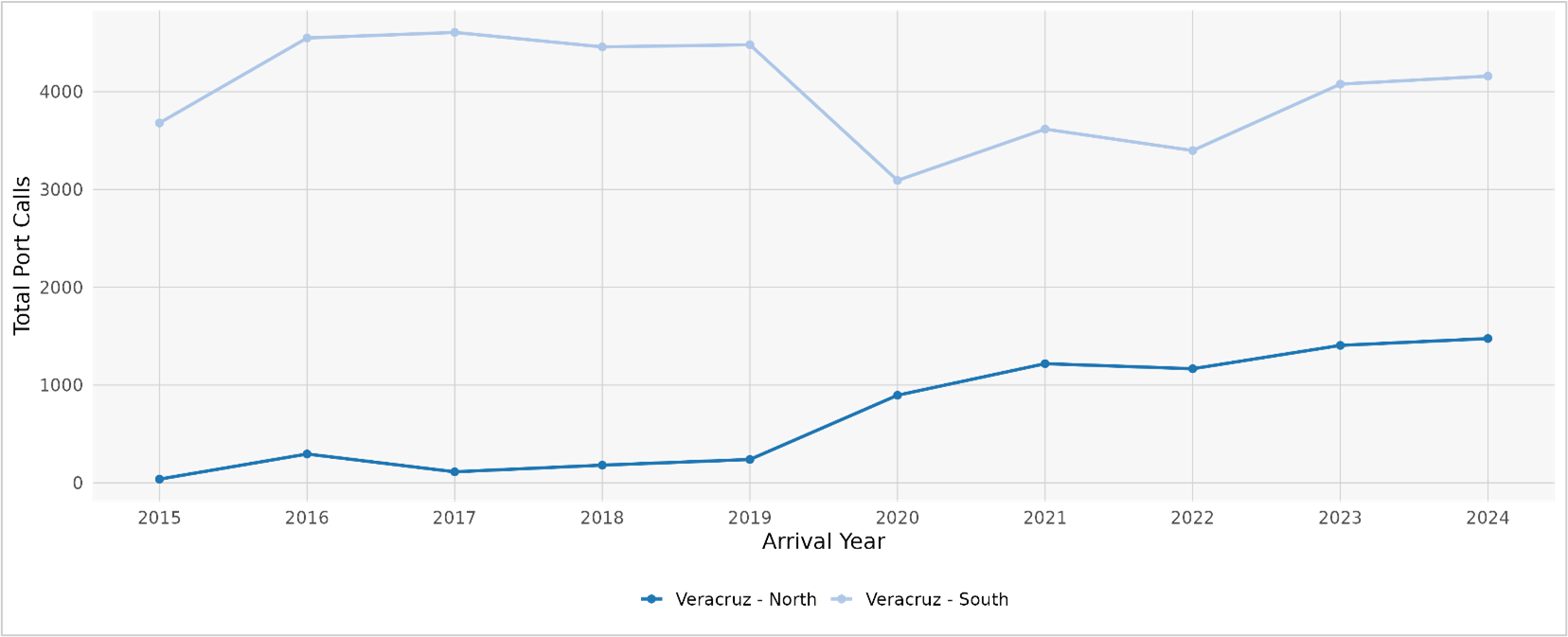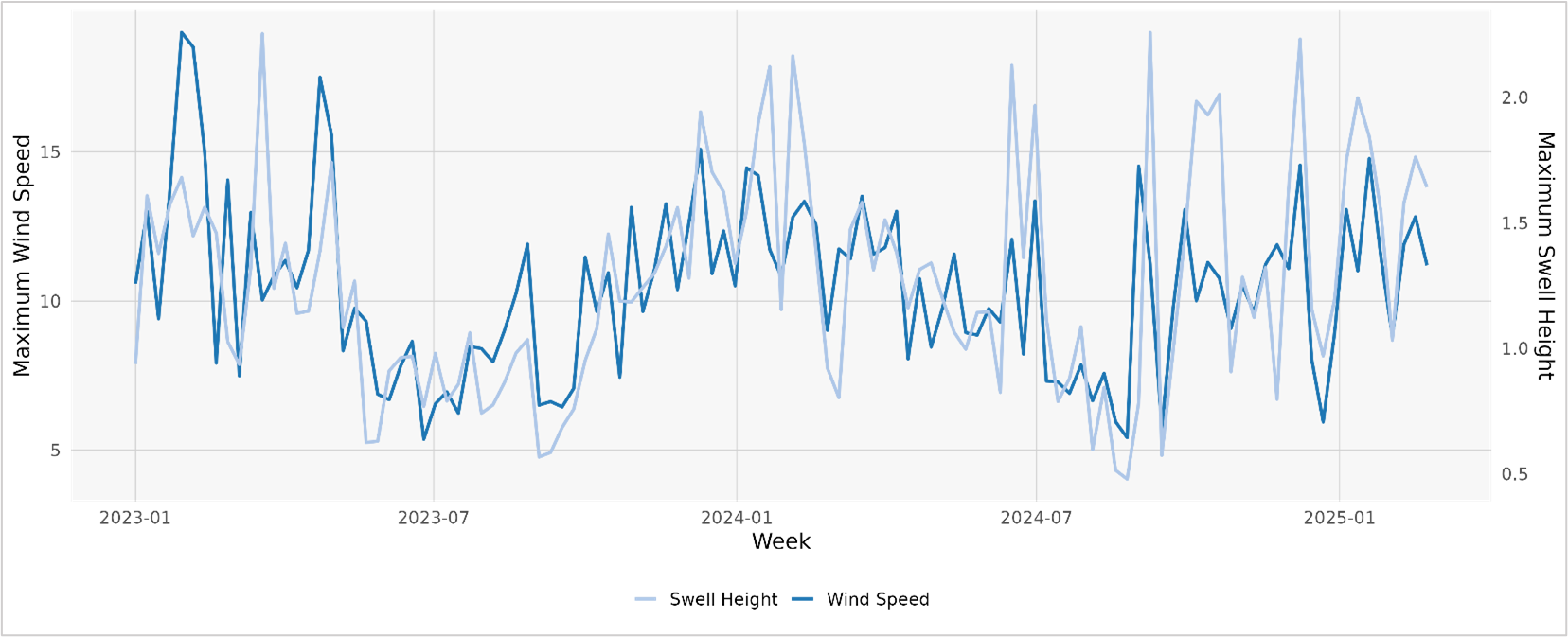In the last six months Gard has been notified of five incidents of mooring line failures at the port of Veracruz. Our local correspondent, Pinedo Abogados, attributes these failures to the ongoing port expansion construction at the Northern terminal and bouts of increasingly severe weather, specifically cold fronts.

Veracruz Port: Mooring line failures due to port expansion and weather
Published 03 April 2025
Port expansion
The New Port of Veracruz has increased Veracruz's commercial load capacity from 23 million to 95 million tons, thereby establishing it as Mexico's foremost port. The Port Administration of Veracruz is currently supervising the construction of the west breakwater, although other components of the project remain incomplete.
A large section of the inner breakwater is also currently under construction. Completion of this breakwater is anticipated to diminish wave impact and alleviate hazards for vessels encountering intense northerly winds.
Rising trend of mooring lines parting and recommendations
Recurring mooring line failures pose a significant risk at both North and South Bay port terminals during the September to April cold front season. High waves and winds exceeding 90 km/h cause severe vessel pitching, leading to excessive tension and breakage of mooring lines, even reinforced ones. This has resulted in numerous incidents, including one in December 2024 where a vessel damaged multiple other vessels after breaking its lines, and in another instance, tugs were needed to secure a vessel that had six of the mooring lines parting, including spares.
The Port of Veracruz currently does not offer a mooring rope rental service or supply of spare mooring ropes. Vessels must therefore arrive with sufficient mooring lines of their own. To enhance safety, the container terminal has implemented shore tension mechanisms that automatically manage mooring line tension during adverse weather, mitigating the impact of vessel movement and wave action.
While the Port Authorities have not issued any formal warnings about mooring incidents, it is important that the owners and crew of vessels calling the port of Veracruz are aware of these risks. Pinedo Abogados recommend that owners, managers and masters actively seek information from port authorities, pilots, and their local agents on matters such as:
historical incidents,
mooring configurations (including rope requirements and layout of bollards),
weather alert systems,
current conditions, and
tugboat availability.
Should berth conditions become unsafe, vessels are advised to arrange for a timely departure to sea.
Traffic movement and weather patterns
AIS data shows that the Southern terminal consistently experiences a significantly higher volume of traffic. While the Northern terminal, currently undergoing expansion, saw a gradual increase in port calls starting in 2019, the Southern terminal remains the dominant hub. Notably, bulk carriers, particularly handysize vessels, constitute the majority of calls at the port.

Number of port calls each year for both the terminals
Furthermore, weather parameters, specifically wind speed and swell height, play a critical role in mooring safety. Wind exerts lateral pressure on vessels, stressing mooring lines, while swell induces vertical and horizontal movements, leading to cyclical loading and potential line fatigue. Both wind and swell exhibit peak activity between November and March, coinciding with a recorded increase in mooring incidents in this port. This correlation underscores the significant impact of these weather conditions on vessel safety within the port.

Weekly maximum wind speed (m/s) and swell height (m) (January 2023 – March 2025)
Contractual concerns
Incidents involving mooring lines parting may lead to claims by owners and charterers, for:
(a) breach of safe port/berth warranties; or
(b) implied indemnity following Charterer instructions.
Unsafe port claims
Charterers are obliged to only order the vessel to ports, which at the time the order is given are safe. Whether a port can be said to be safe hinges on whether a ship can “reach it, use it and return from it without, in the absence of some abnormal occurrence, being exposed to danger which cannot be avoided by good navigation and seamanship…” (The Eastern City).
If a vessel requires more than the usual number of spare mooring ropes on board to manage incidents of frequent breakages due to high wind and waves, it could be argued that this goes beyond the threshold of ordinary seamanship. It is also worth enquiring before arrival about the adequacy of the mooring systems in the port, as advised by our correspondent (above).
Implied Indemnity
The general principle is that where an owner complies with an employment order which exposes the vessel to a risk which owners have not agreed to bear, that risk must exceed a general navigational risk but rather must flow directly from Charterers’ orders.
Whether these claims succeed will depend on the specific facts surrounding the incident giving rise to the claim, and we recommend that members notify the Club as soon as possible in case of any incident.
We would like to thank Pinedo Abogados for their contribution to this alert.
Relevant Gard articles
Beware: Increase in cases of broken mooring lines
Additional mooring ropes – who pays?
“Stop, Think, Stay Alive” – understanding the risks in mooring operations


